| Constructed last year, the 300-ton-per-hour Clearco prep plant produces a premium quality mid-vol met coal. |
AUTOMATED PLANT BALANCES ASH SPECIFICATIONS WITH FINES RECOVERY
By Steve Fiscor, Editor-in-Chief
At the end of the hollow near the headwaters of Clear Creek in Greenbrier County, W.Va., sits one of America’s newest prep plants. Last summer, South Fork Coal, a subsidiary of Xinergy, completed construction of the Clearco plant and began washing the Sewell coal produced at its Blue Knob surface mine. Coal from the Sewell formation is considered a premium quality mid-vol coking coal and it has been mined in this region near Rupert, W.Va., for more than 100 years.
Greenbrier County is one of the more scenic parts of the Mountain State. Sitting at 3,800 ft, the installation’s elevation above grade, compared to Hinton and the New River, is significant. The rail line that South Fork restored to give CSX access to its loadout runs parallel to prime trout fishing waters. On the ridge above the prep plant, 67 windmills generate electricity for a renewable energy startup.
South Fork brought this property into production in a little more than two and a half years after acquiring the coal leases from a private owner. That’s a remarkable achievement, considering the time it takes to purchase equipment, hire capable people and build the infrastructure to support a mining operation, let alone the permitting process.
For Bob Hypes, general manager, South Fork Coal, seeing the project become a reality has been one of the most rewarding experiences of his 30-year career as a project engineer. He began his mining career with an engineering group, before going into construction and eventually operations management. He recalls getting emotional when that first train arrived at the Clearco loadout. For the first year, he worked alone preparing to execute the project and he watched South Fork Coal move from concept to reality in less than three years. “In the coal world, that’s hustling,” Hypes said.
Xinergy invested $20 million in the Clearco installation, which includes a prep plant, rail loadout and the rehabilitation of 8.5 miles of rail infrastructure. “Xinergy acquired the property in January 2011,” Hypes said. “By the end of the year, we were moving overburden and continuing to drill the deposit and we quickly realized we were going to need a prep plant and a loadout to make this project a success.” Hypes and his team turned to The Daniels Co., which evaluated the coal and proposed a plan.
Construction on the Clearco project began during December 2012, which is not the most ideal time to start building a prep plant, recalled Surendra Jain, president, The Daniels Co. During January, they were driving pile for foundations and South Fork shipped its first train August 21, 2013.
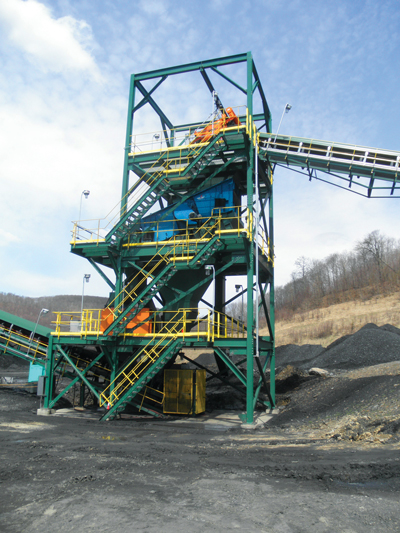 |
| A scalping station prevents rock and tramp metal from entering the plant. |
Designing the Right Plant for the Application
With a raw feed capacity of 300 tons per hour (tph), the Clearco plant is a relatively small plant. “The plan was to consistently produce a quality mid-vol coking coal, not to be a high-volume producer,” Hypes said. “We have a specialty product. Our ash ranges from 2% to 6.5%, but our typical Sewell product is 6% ash.”
When the decision was made to construct a prep plant, South Fork reached out to three firms that build prep plants. With a pretty good grasp of the costs, they ultimately decided to award the project to The Daniels Co. The decision was based on the scope of the project, the price and the schedule, Hypes explained. South Fork wanted to build the plant in seven months and The Daniels Co. had enough experience to make that happen.
“As a startup company that was mining coking coal, we needed to be self-sufficient, not just a contractor supplying raw coal to another company,” Hypes said. “The shipping costs and logistics just made more sense financially by washing it ourselves and loading railcars rather than trucking it to another location and selling our product under someone else’s brand name.” This was Xinergy’s first met property, and the company wanted to get it up and running as quickly as possible.
South Fork’s Blue Knob operation is mining coal from a couple splits of Sewell coal. Sewell coal is a very soft, fine coal with a grind of about 80 ±. “The ash in the raw coal, which has a lot of fines, is low and it was important to design the operation of the plant to maintain a very high level of efficiency,” Jain said. “As an example, when the stoker coal is produced, the specific gravity (s.g.) for the media is set at 1.25 to 1.28. If the plant is not designed to wash properly at that low s.g. set point, a lot of coal will simply report to the refuse.”
To meet different specifications, the s.g. for the plant could swing from 1.28 to 1.55, and the variation in the amount of fines only complicates the situation. “We set the design parameters to account for the variation and still maintain a high level of process efficiency,” Jain said.
In addition to the fines, this is one of the few plants where the clean coal yield can reach the high 80% to low 90% range, Jain explained, and the capacity of the clean coal circuit compared to the overall capacity of the plant is greater than that of most plants.
“The strengths of this facility lie in the fine tuning and the efficiency,” Hypes said. “We change the gravities up and down to meet various customer needs, and all the time we are striving to recover those fines. We have a lot more fines than most plant operators normally encounter.”
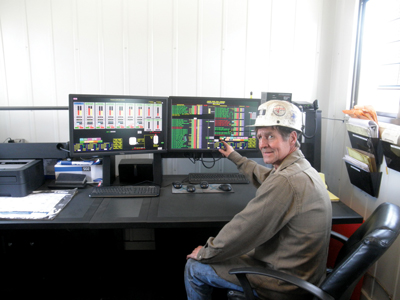 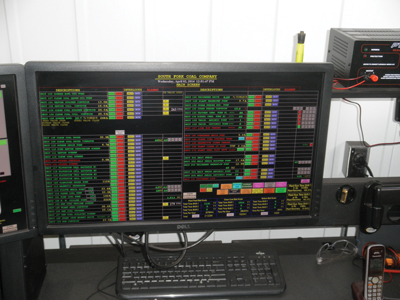 |
| Plant Superintendent Roy Palmer monitors all activities in the plant (left). The software alerts the operator when something is wrong and tells him why (right). |
Plant Operations
The Clearco plant is fully automated with interlocking level and gravity set point controls. “We have a total of nine people running this plant two shifts per day,” Hypes said. “We have a superintendent, a control room operator and technicians in the plant who also operate heavy equipment.” The entire prep plant can be operated from one computer. In a sophisticated, yet simple control room, the plant superintendent keeps watch over two large monitors. Programmable logic controllers (PLCs) are constantly reporting information to the system.
Prior to entering the plant, raw coal passes through a scalping station. Eriez magnets remove tramp metal from the coal before Cogar feeders discharge coal onto a Conn-Weld scalping screen. The Daniels Co. designed the conveyor galleries and the hardware was supplied by Precision.
The Clearco plant has three circuits. The five-story gravity-fed system begins with Warman slurry pumps feeding an FLSmidth/Krebs large-diameter, heavy-media cyclone at the top of the building. The intermediate size fraction is processed with spirals from MDL Technologies. The fines are recovered by FLSmidth (Wemco) flotation cells.
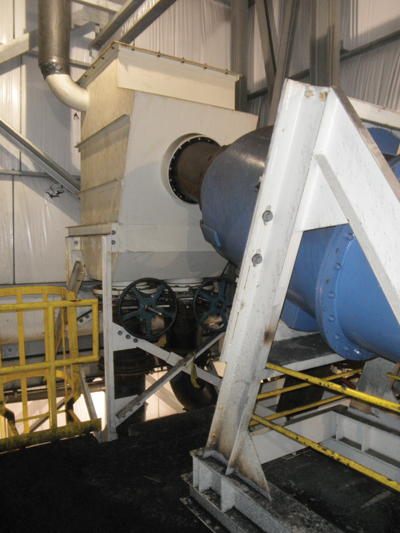 |
| A heavy media cyclone has been modified for a stoker circuit. |
The plant uses three sets of Conn-Weld screens. The raw coal screen makes the initial size separation down to 1 mm. The plant also has a clean coal drain-and-rinse screen as well as a refuse drain-and-rinse screen. A set of two-stage sieve bends remove water and fines from the clean coal spirals. A Decanter screenbowl centrifuge dewaters the fines recovered from the flotation cells.
Belt presses squeeze the water out of the refuse recovered from the thickener. The refuse is backfilled in the pit in a defined refuse area at the surface mine.
The Clearco plant has roughly 27,000 tons of clean coal storage capacity or three trains. “We did not install reclaim tunnels or stacking tubes,” Hypes said. “We use above-ground feeders and a radial stacker to stockpile coal, which is handled with loaders and dozers.”
Met coals are finer, and not as blocky as steam coals. “That’s why we have to use a car topper in the summer and a freeze proofing agent in the winter,” Hypes said. The freeze proofing agent they use is made from beet juice.
Unlike steam coals, fines are not as much of an issue with coking coals. “Some customers care about fines and others do not,” Hypes said. “One customer buys a low-ash stoker product (1/8 in.). We wash it at a lower s.g.” The lower ash content (2-2.5% ash) reduces slagging in the furnace. The fines from the stoker circuit are blended with the higher gravity wash. They will reprocess the refuse from the low gravity set point at the high set point to recover all of the coal they can between the 1.25 and 1.55 s.g. fraction.
South Fork constantly monitors quality. They continuously test the feed entering the plant. Sampling systems supplied by James A. Redding monitor quality on the clean coal belt and at the loadout. The company sends samples to Gallagher Coal Research in Beckley every day.
The plant could run more than 1 million tpy. It’s currently operating at 25% to 50% of total capacity. Last year they operated for six months, and 2014 will be the first full year of production. “With a relatively small budget, we feel we got the most for our money,” Hypes said. “And, we have room to grow.”
Building the Clearco Plant
Even though they had to deal with the winter weather, everything went well during construction. “The toughest part with the accelerated timeframe was fabrication,” Hypes said. “That required true project management. Keeping the flow of raw materials to the plant was vital. Some weeks construction crews worked seven days with a skeleton crew supporting them on an afternoon shift.” Trimble performed all of the structural steel work and JC Electric wired the plant and ran all of the conduit.
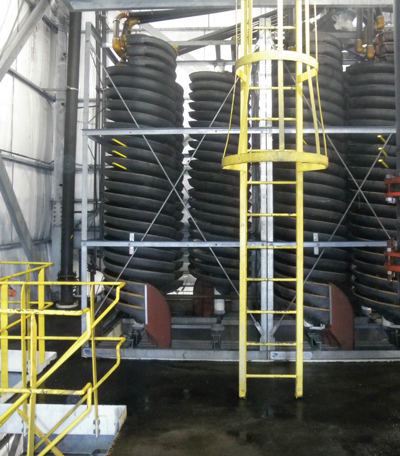 |
| Spirals are used to clean the intermediate size fraction. |
Normally it would take eight to nine months to build a plant of this size, Jain explained. “The completion time really depends on when construction begins,” he said. Productivity suffers during the winter months. Steel workers can’t work in extreme conditions. The plant was scheduled to start in mid-August 2013, but it actually began operating on July 1 with an accelerated schedule.
The Daniels Co. did all of the computer programming. “Prior to commissioning, we simulate everything to test the interlocks and the overall flow,” Jain said. “When the computers are installed in the field, we are usually ready to run within a day.”
“The structural steel in the plant is galvanized, which is much better than any paint system that you can get,” Jain said.
The property had an existing rail footprint that was last operated in the mid-1990s. In fact, some of the historical rail infrastructure on the property dates back to 1928. Xinergy is probably the third or fourth operator to work this piece of property and it invested about $2.6 million to rehab 8.5 miles of track and install a new 2,500-ft rail siding to service the loadout.
Because of the grades between the Clearco plant and Hinton, CSX will only dispatch 75-car trains to the mine. Clearco is one of highest elevations CSX loads in West Virginia and they have to break the train and load half at a time.
Since startup, everything has been running fine, Hypes explained. “And, we modified the plant to add a stoker circuit, which involved moving a cyclone and cutting some concrete,” Hypes said. “It was added within the existing footprint without interrupting production.”
Fully Automated Controls
Everything in the plant is monitored from the Clearco control room. The system consists of two screens. On the left side, a loop screen visually demonstrates the difference between present values (PV) and the set point (SP). On the right side, information is delivered in a logical order that follows the flow of the plant. At each level, the technician can get detailed information on each device or system, such as the amperage on various motors, the torque on the rake in the thickener or the chemical levels.
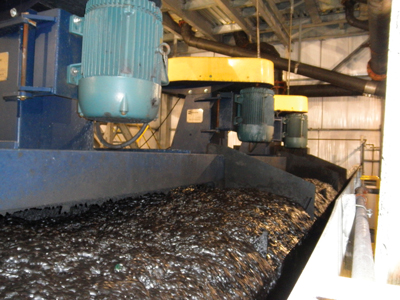 |
| Froth flotation is used to recover fines. |
When the PV and SP bars are at equal levels, the system is working properly. A significant difference in the PV vs. SP values signals that the plant is not running well. The operator gets a visual signal. If the situation deteriorates, an audible warning sounds.
When the PV is lower than the SP during regular operations, the computer will take action. On a sump for example, the operator can see the valve open and track the rising water levels in real time. When a warning is issued, the system will tell the operator what piece of equipment is having problems and why.
To produce the low ash coal, the operator simply places the cursor on a box, types in the new gravity set point (1.25) and the system takes over. The computer also sequences the starting and stopping of all machinery, which is commonly referred to as interlocking. If the raw coal crusher, for example, goes down, all of the equipment preceding it is de-energized. Proper sequencing is crucial as an over-running belt or an over-flowing sump could cost the plant as much as two hours of downtime.
The control room and the electrics are housed in an intermodal container that is attached to the side of the plant. Dust is controlled using positive pressure ventilation. Both the plant and the loadout use a satellite system (HughesNet) for an Internet connection.
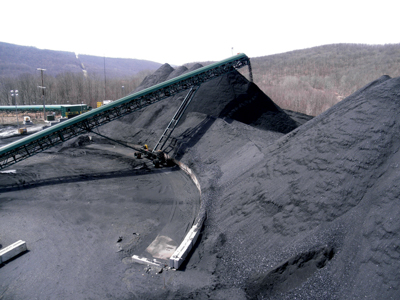 |
| Using a radial stacker, South Fork can stockpile three trains (27,000 tons) of coal. |
The Clearco loadout is as automated as the prep plant. The loadout uses a double batch-weigh system designed by Kanawha Scales & Systems. It allows the operators to load railcars to within 99% of their rated capacity. “We load cars in three minutes,” Hypes said. “Once the cars are loaded, the system updates and transmits the EDI file to CSX before the train is out of our sight.” The information is tied to an RFID tag on each railcar.
“The technology involved in this project is not as amazing as completing construction on time and making the plant work as efficiently as possible,” Hypes said. “The operators now have a good feel for the plant. They know how it responds. The superintendent knows what’s going to happen before he makes an adjustment.”
Hypes takes a lot of pride in what South Fork has accomplished in a short period of time. He has only missed one train loading since the plant began running.




